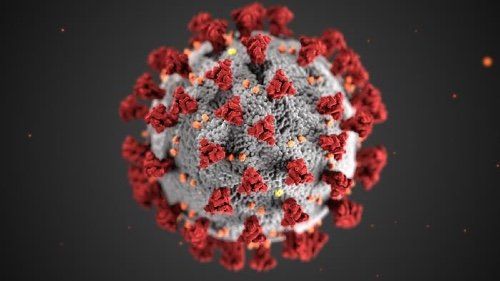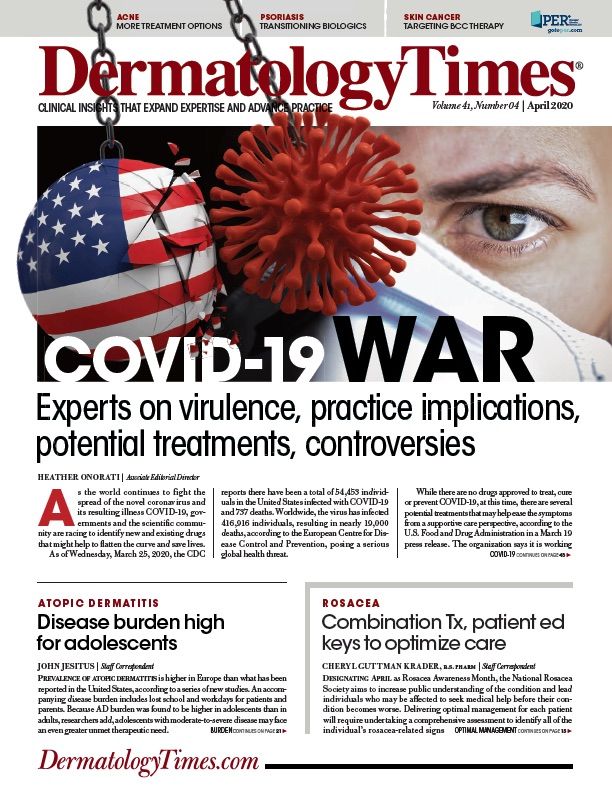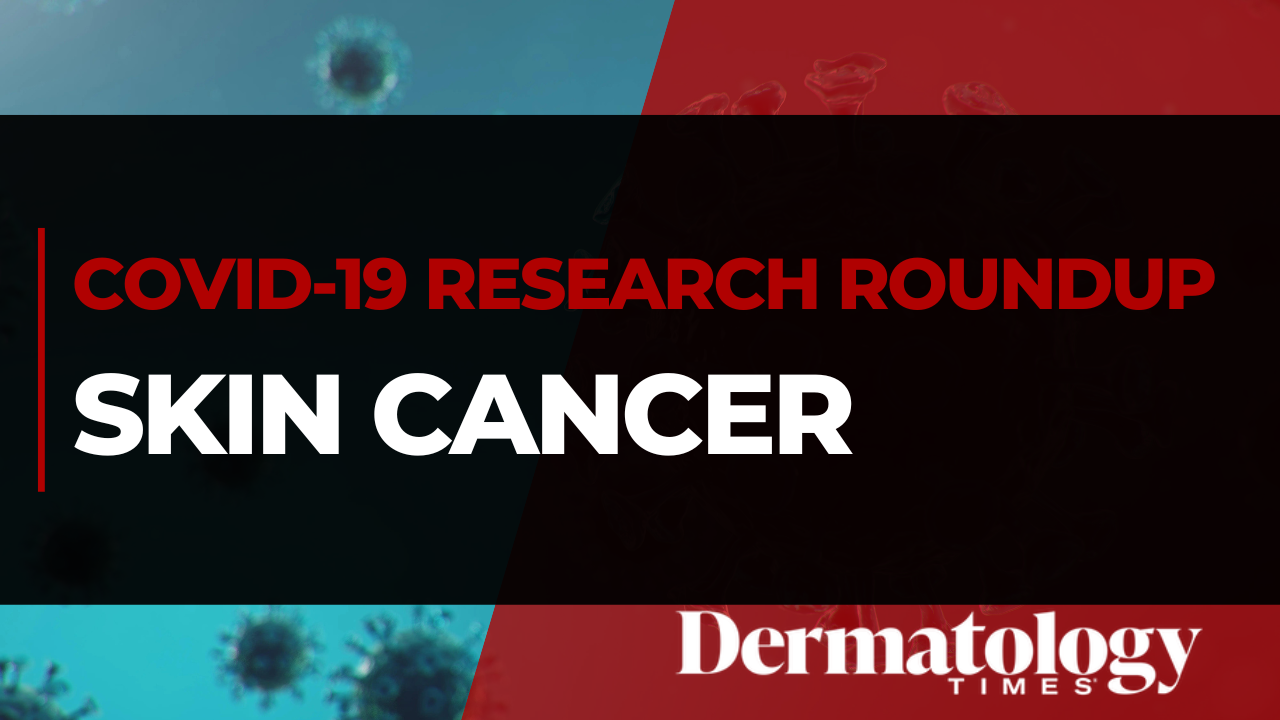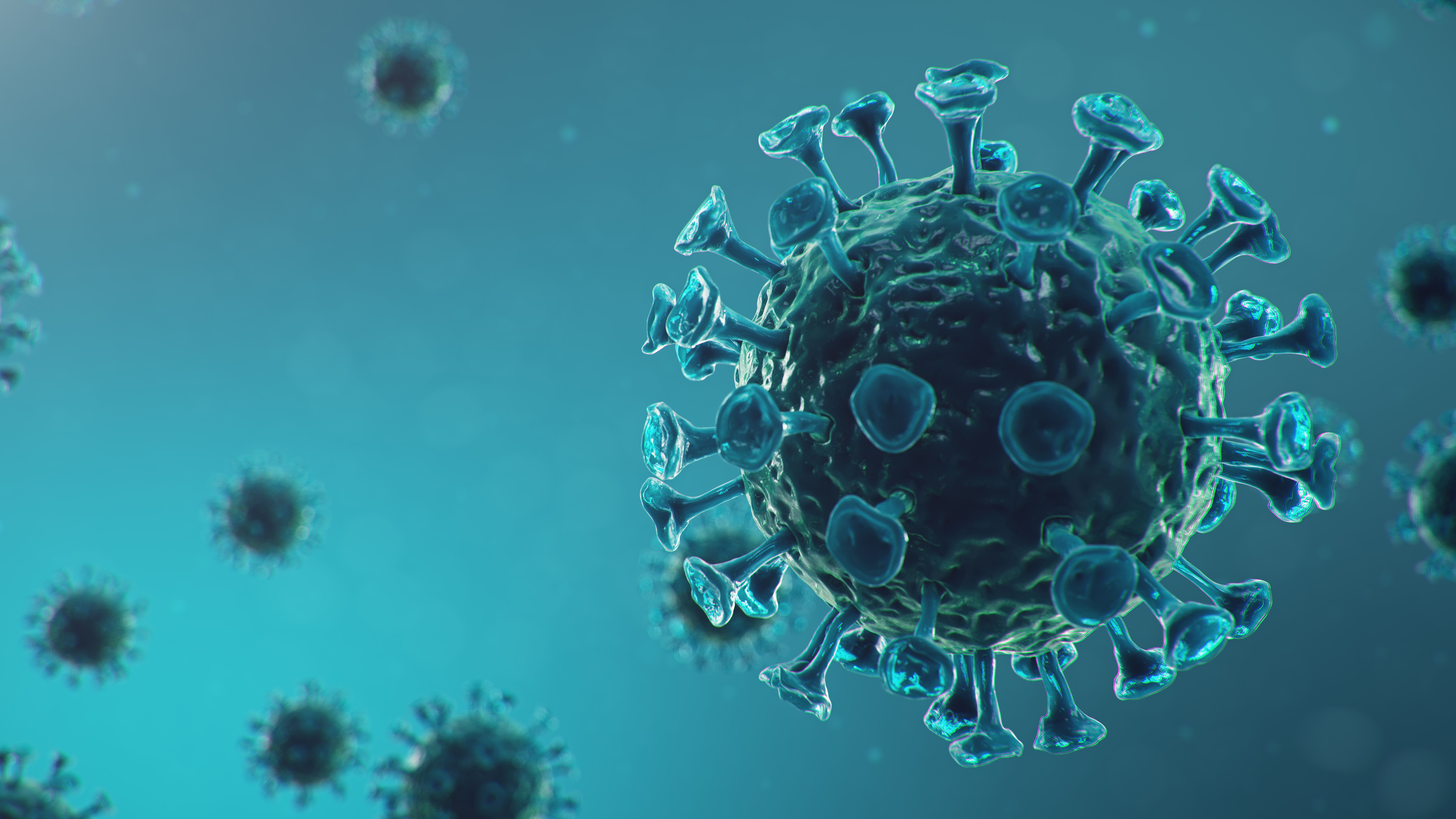- Case-Based Roundtable
- General Dermatology
- Eczema
- Chronic Hand Eczema
- Alopecia
- Aesthetics
- Vitiligo
- COVID-19
- Actinic Keratosis
- Precision Medicine and Biologics
- Rare Disease
- Wound Care
- Rosacea
- Psoriasis
- Psoriatic Arthritis
- Atopic Dermatitis
- Melasma
- NP and PA
- Skin Cancer
- Hidradenitis Suppurativa
- Drug Watch
- Pigmentary Disorders
- Acne
- Pediatric Dermatology
- Practice Management
- Prurigo Nodularis
- Buy-and-Bill
Publication
Article
Dermatology Times
COVID-19 pandemic requires vigilance, not panic
Author(s):
In combatting the pandemic, dermatologists must take critical steps to adapt operations while still providing essential patient care and preventing exposure in o ffice settings, experts say.

As of mid-March, the pandemic continued to escalate, with new cases and findings about the COVID-19 virus coming daily, revealing the implications on dermatology practice and patients. In combatting the pandemic, dermatologists must take critical steps to adapt operations while still providing essential patient care and preventing exposure in office settings, experts say.
VIDEO: Dr. Jules Lipoff discusses the use of telemedicine during the COVID-19 crisis
Dermatologists are well-aware of the ability of viruses to cause regular cold symptoms, says Bobby Buka, M.D., cofounder of The Dermatology Specialists in New York. COVID-19, the infection caused by the SARS-CoV-2 virus, is similar in that regard.
“But the virulence of COVID-19 is more impressive than prior versions, and its mortality and morbidity rate is higher than its predecessors,” he says. As of March 25, the U.S. Centers for Disease Control (CDC) had tallied 737 fatalities among 54,453 cases, a 1.4% mortality rate.
In outpatient settings, Dr. Buka says, physicians may think that because COVID-19 is not a dermatologic condition, they won’t be on the frontlines.
“But in a pandemic situation, we’re all on the frontlines, and I trust my colleagues to be part of the unfolding efforts to control the spread of this virus,” he says.
In a message March 19, to members, George Hruza, M.D., outgoing president of the American Academy of Dermatology (AAD), shared the latest insight related to the dermatology specialty, which included guidance on self-protection, as well as the protection of staff and patients. Among the resources provided, were tips for patient screenings and effective disinfecting solutions for use around the clinic based on guidance from the Centers for Disease Control (CDC) and the World Health Organization (WHO). AAD is compiling all resources related to the pandemic for members, which can be found at www.aad.org/coronavirus.
As in other specialties, dermatologists’ practices have been verbally screening for viral exposure, ideally before patients enter a facility, says Ted Rosen, M.D., professor and vice chair of dermatology at Baylor College of Medicine, Houston.
RELATED: COVID-19: Experts discuss virulence, potential treatments, controversies
“It is advisable to have schedulers screen anyone calling in for an appointment,” he says.
He suggests asking about symptoms of flulike illness; travel in the past two weeks to international and domestic locations currently experiencing significant outbreaks; proximity to anyone subsequently diagnosed with coronavirus infection and recent participation in cruises.
Dr. Rosen adds, “Offices should have a plan in place about what to do if a dermatological patient incidentally presents with signs (fever) and symptoms (cough, shortness of breath) which suggest COVID-19, even in the absence of pertinent travel.”
He suggests having adequate personal protective equipment (PPE) available, and appropriate methods of contacting authorities for up-to-date recommendations regarding next steps in place.
The plan should include any procedures for informing patients of changes to scheduling or policies and this should be communicated clearly to your entire staff, according to the CDC recommendations. Sick staff should be encouraged to stay home.
Dermatology offices are not equipped as emergency rooms and urgent-care centers, notes Dr. Buka. However, he says, most dermatologists carry viral transport media (VTM) for culturing viruses such as herpes simplex. The COVID-19-specific testing kits now being distributed provide faster diagnosis.
RELATED: AMA resources for private practice physicians during COVID-19
IDENTIFYING INFECTION
Signs and symptoms of infection, according to CDC, include fever, cough, sore throat and shortness of breath. Whether there are any skin related signs is a matter of debate.
According to a February 18 New England Journal of Medicine report, out of 126 German travelers returning from China, one (who had passed symptom-based screening) subsequently tested positive for SARS-CoV-2 and was found to have a faint rash.1
As SARS-CoV-2 is a coronavirus, says Dr. Buka, one might expect a sandpaper-like morbilliform eruption to impact 10% to 15% of patients. A classic leukocytic vasculitis presenting as purpura or ecchymoses on the lower extremities could impact approximately 2% to 3% of patients, he adds.
Upper-respiratory infection (URI) symptoms - scratchy throat, mild fatigue and headache - typically precede dermatologic manifestations, says Dr. Buka. But in 80% to 90% of COVID-19 cases, he says, URI presentations are mild and may go unnoticed. The rash can occur either concomitant with, or two to 14 days following URI symptoms, he says.
“That two- to 14-day range also corresponds with the incubation period of COVID-19, which means we can get exposure and the rash alongside the URI symptoms,” he suggests. Recently, a patient presented to Dr. Buka with a girdle rash but no fever, which ruled out COVID-19.
“But,” he says “if we have fever and morbilliform rash, currently that’s going to be at the top of my differential. It can be helpful among the constellation of other symptoms to make an earlier diagnosis.”
RELATED: Experts advise caution over early, emerging treatments
However, Dr. Rosen says that although very few anecdotal reports indicate the presence of a poorly defined, faint morbilliform eruption with COVID-19, a skin rash is not considered characteristic; nor is it likely to be.
Older literature regarding viral exanthems are suspect, he adds, because diagnostic testing for viral diseases is much more sophisticated today.
Rodney E. Rohde, Ph.D., M.S., says that no solid evidence or peer-reviewed publications report issues with SARS-CoV-2/COVID-19 being transmitted to skin eruptions and similar dermatology symptoms. He is professor and chair of the Clinical Laboratory Sciences Program at Texas State University. He also serves as a research dean for the College of Health and associate director of the Translational Health Research Center at the University.
“If these skin eruptions/rashes are an early sign of COVID-19,” he says, “then that certainly could be used as a possible screening tool for testing - and diligent PPE (use) for healthcare workers of all walks.”
PUBLIC HEALTH MEASURES
Local emergency declarations, cancellations and social distancing are all effective, time-tested public measures for containing or attempting to stop microbial outbreaks, Dr. Rohde says. While people understand the critical importance of handwashing, physicians and officials must raise awareness of hightouch surfaces because SARS-CoV-2/Covid-19 (and other microbes) can remain viable for several hours on touchscreens, handrails and elevator buttons.
The World Health Organization recommends wiping down all chairs and arm rests, exam room tables, counters, doorknobs, light buttons and handles, faucet handles, all bathroom surfaces, reception area counters, all lab surfaces, and all kitchen area surfaces; keep trash cans empty and wipe down the inside and outside of containers regularly and thoroughly.
RELATED: Malaria drug hydroxychloroquine may treat COVID-19
In the coming weeks, Dr. Buka anticipates seeing fewer patients overall as people have increasing trepidation about leaving their homes. Dr. Rosen adds that some patients who sought face-to-face encounters for skin issues are requesting “virtual” visits, real-time or otherwise.
Physicians looking to leverage telemedicine technology with patients exhibiting respiratory symptoms requiring dermatology care may be able to now receive reimbursement from Medicare, according to the AAD, which offers help with getting started and assistance with coding through its membership resources.
With no vaccine presently available, says Dr. Rohde, the number of U.S. cases will almost inevitably rise. That will mean federal government support will become more important, but it doesn't mean people should panic, he says.
Dr. Rosen emphasizes that most patients affected by COVID-19 will have mild disease and completely recover. It is the elderly patient with underlying chronic disease who is at highest risk for severe disease.
"We all, as healthcare providers, should emphasize the commonplace and simple precautions that our patients can take to mitigate the risk, and try to deemphasize doom-and-gloom predictions of apocalyptic disaster. There’s too much hysteria already.”
As of this publication, Dr. Hruza has appointed an Ad Hoc Task Force to assess the specialty’s needs, share new information, and provide ongoing guidance and information, which can be found on the AAD website.
Disclosures:
Drs. Buka, Rohde and Rosen report no relevant financial interests.
References:
1. Hoehl S,Berger A,Kortenbusch M, et al. Evidence of SARS-CoV-2 infection in returning travelersfrom Wuhan, China. N Engl J Med.2020 Feb 18. doi: 10.1056/NEJMc2001899. [Epub ahead of print]






